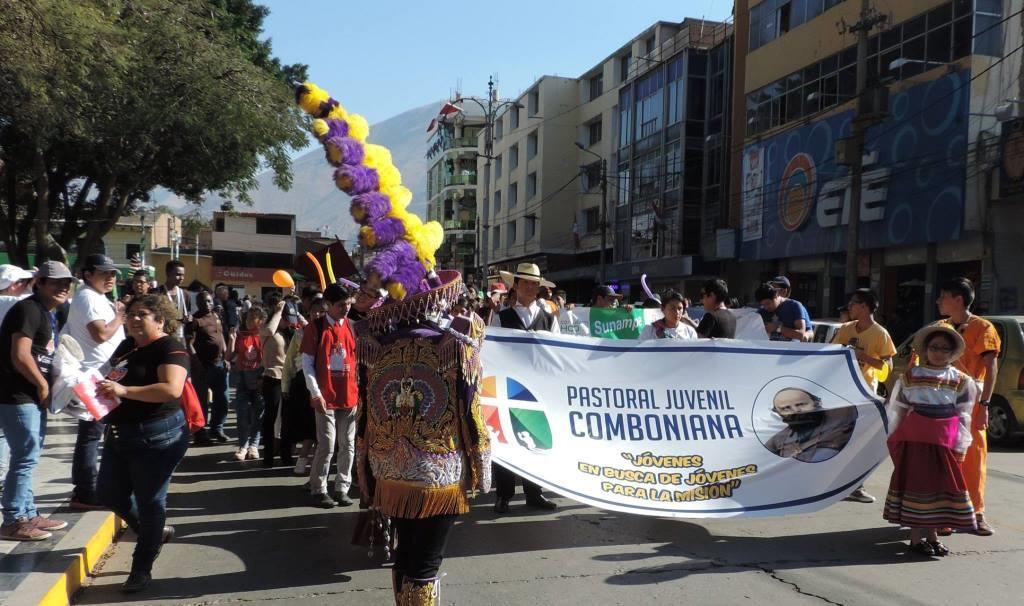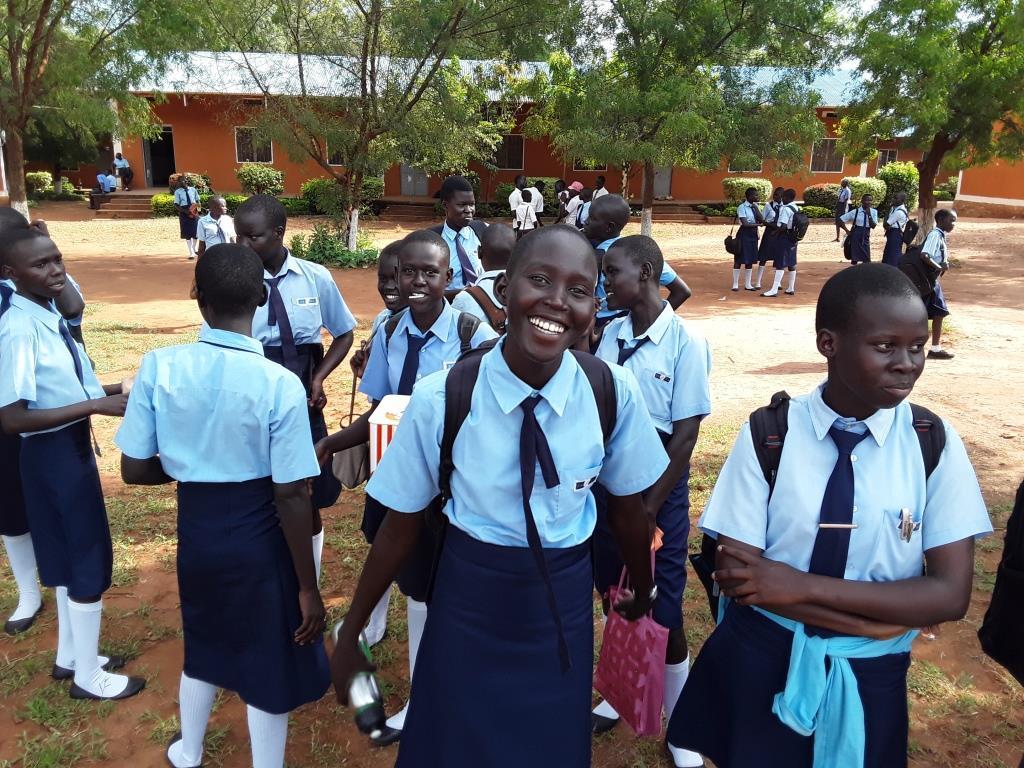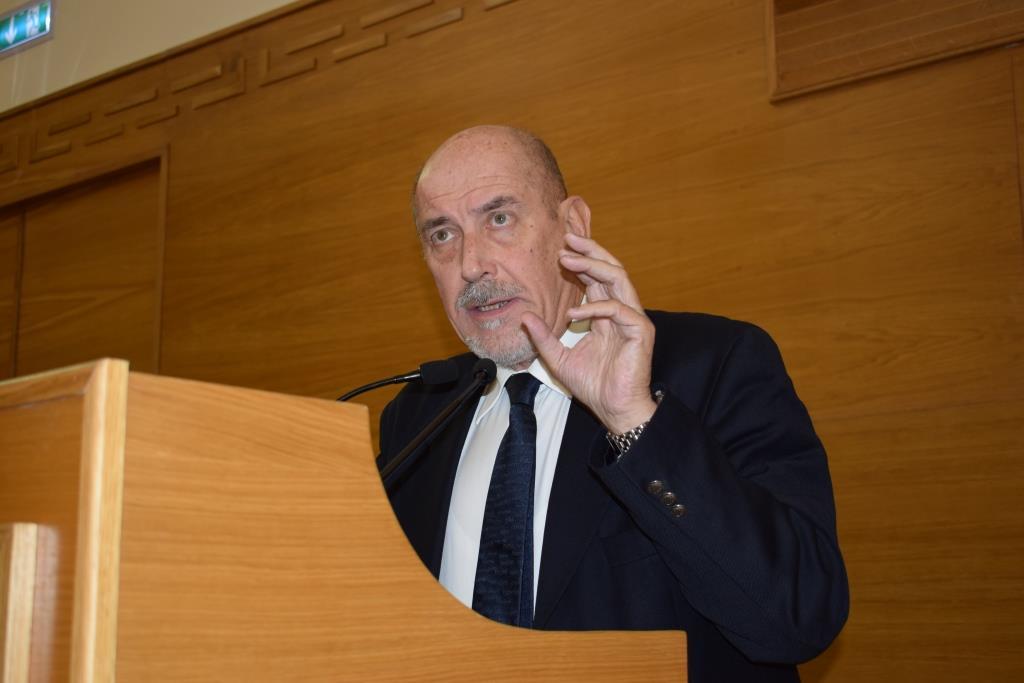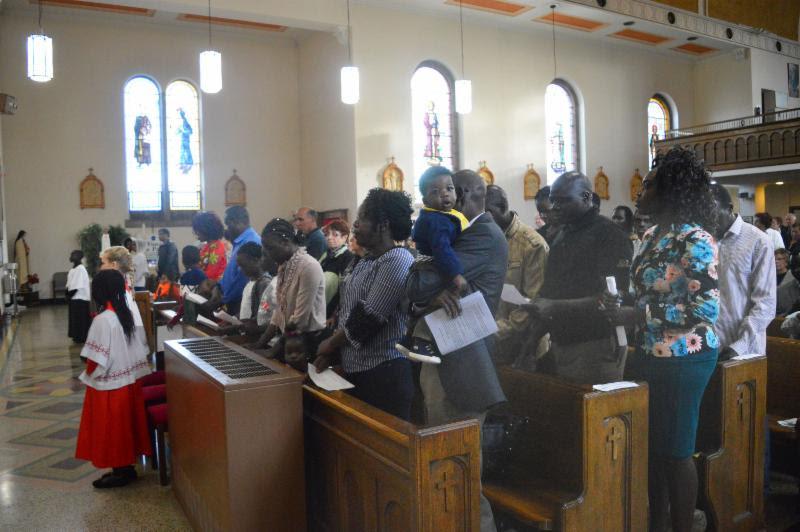Daniel Comboni
Missionários Combonianos
Área institucional
Outros links
Newsletter
Tuesday, September 19, 2017
The history of the 150 years of Comboni’s Institute started in Europe and developed first in Africa: Egypt, Sudan, Uganda, Ethiopia, South Africa… according to the Founder’s life and plan: “Save Africa through Africans!” But in the middle of the last Century, different Church appeals (from Popes and Bishops) pleaded with our Institute and many other Congregations to send Gospel’s labourers to Latin America, for urgent missionary and pastoral tasks: first evangelisation and new evangelisation (cfr. RM, n. 33). That is why, in the history of our 150 years, the Comboni’s presence in Latin America occupies a great consistent chapter. [...]
Latin America:
some inspiring
selected topics
The history of the 150 years of Comboni’s Institute started in Europe and developed first in Africa: Egypt, Sudan, Uganda, Ethiopia, South Africa… according to the Founder’s life and plan: “Save Africa through Africans!” But in the middle of the last Century, different Church appeals (from Popes and Bishops) pleaded with our Institute and many other Congregations to send Gospel’s labourers to Latin America, for urgent missionary and pastoral tasks: first evangelisation and new evangelisation (cfr. RM, n. 33). That is why, in the history of our 150 years, the Comboni’s presence in Latin America occupies a great consistent chapter.
Here below, I propose three topics for information-reflection:
A) Dates and numbers show Providence’s plan and human strategy for expansion.
B) Missionary animation was and still is one of the most positive field of work in America as Comboni Missionaries.
C) “Option for the poor and Theology of Liberation” - steps and evolution from strong debates to a new statement: Option for the poor is a special form of Christian charity, implicit in our Christian faith.
A – Arrivals and missionary purposes of the Comboni family in America: north-centre-south
1938, September, PERU: three German speaking Combonis ‘MFSC’ (Frs. Alois Ipfelkofer, Andreas Riedl, Michael Wagner) arrived in Pozuzo parish, diocese of Huanuco (central Peru), for pastoral/missionary work among German speaking migrants and local indigenous.
1940, the ‘FSCJ’ arrived in USA; however, their central community and the Provincial house opened in Cincinnati only in February 1947.
In response to the calls of Pius XII for new pastoral workers in Latin America, FSCJ opened in:
1948, MEXICO, Baja California, a new missionary field;
1952, BRAZIL, Ibiraçu (South Brazil, for vocations); and Balsas (North, missionary field).
1955, ECUADOR, Esmeraldas, for missionary work among Afro-Americans, indigenous...
The first purpose of these new presences was: Pastoral activities in abandoned parishes among baptised Catholics (most of the population), indigenous (also some groups of non-Christians), all of them living practically in situations demanding a first-evangelisation approach.
The social context of generalised poverty became very demanding; the Church encouraged a strong commitment of the faithful in the fields of Justice-and-Peace, with a clear Evangelical option for the poor and concrete social programmes, especially in Brazil. This social environment played a significant role, defining the pastoral activity, spiritual life and personal options of many confreres, including orientations for formation field (novices, scholastics…) and missionary animation. Such social mentality had a strong influence also in the rest of the Institute (mainly in Europe), especially in formation programmes, general orientations (assemblies, chapters…).
A second (but not secondary) purpose of our presence in America was the formation of local Comboni missionaries, with activities of Vocation Promotion, Missionary Animation, even with our missionary magazines (Mexico, Brazil, Peru, Ecuador, NAP, Colombia…) and new houses for formation at all levels, including Novitiate and Scholasticate.
Step by step Combonis’ presence expanded to new countries: from Mexico to Central America, from USA to Canada, from Ecuador to Colombia, from Peru to Chile…
B – Making Latin American Church missionary, more involved in mission, inside and abroad
Missionary Animation was and still is a vital part of the work of the Institute in Latin America. In the last decades of 20th Century, it was said that almost 50% of the world’s Catholics were living in America. However, during the past centuries, Latin-American Catholics have been used to receive from outside missionaries and resources, without sending missionaries abroad.
A new mentality emerged in the 2nd Vatican Council, affirming that: every local Church -old and young alike- is called to share her gifts, receiving and giving (personnel, resources…). Latin American Bishops in their continental meeting in Puebla, Mexico, 1979, approved an important and inspiring missionary commitment:
«The time has finally come for Latin America to strengthen mutual services among the particular Churches and to project herself beyond her own borders, ad gentes. It is true that we still have the need of missionaries. Nevertheless, we must give from our poverty» (cfr. Latin American Bishops' General Conference, Puebla, n. 368).
Inside the Conference of Puebla, this text has been prepared and proposed by two bishops: Roger Aubry, a Swiss CSSR in Bolivia, and Enrico Bartolucci, an Italian MCCJ in Esmeraldas (Ecuador), and approved by the general assembly.
This famous text n. 368 has inspired many MA initiatives and activities inside the local Churches and other institutions. Among the Comboni Provinces, some magazines got a new name: Misión sin Fronteras (Peru), Sem Fronteiras (Brazil), Iglesia sin Fronteras (Colombia). Also the words: “We must give from our poverty” have become a fount of spirituality, both for missionary and common life in general.
The great challenge for the Latin American Church as a whole was: how to transform a Catholic continent into a missionary continent? How to transform an evangelised community into an evangelising community? How to undertake such great enterprise? Various Bishops, some Episcopal missionary committees, Pontifical Missionary Societies (PMS-POM-OMP), international missionary Institutes, a group a Missiologists, small groups of lay people, moved by the Holy Spirit, became deeply concerned and courageous promoters of this new mentality.
A consistent number of Comboni missionaries in all American Provinces have cooperated -and are still cooperating- for this Church Continental plan of MA, in order to create a new missionary awareness in different ways: through our magazines, recollections, retreats and other meetings with youth, children and adult people… Sometimes Episcopal Conferences have entrusted also to some confreres great responsibilities in the organization of COMLAs (Latin American Missionary Congress): especially in the COMLAs of Tlaxcala (Mexico, 1983), Lima (Peru, 1991), Belo Horizonte (Brazil, 1995), Guatemala (2003), Quito (Ecuador, 2008)[1]. In the last ten years, ‘COMLA’ has become also ‘CAM’ (American Missionary Congress), including the Churches in USA and Canada. Generally speaking, COMLAs gather every 4-5 years some thousands of people, during a week, from all American countries (bishops, priests, religious, lay people) and also from other Continents, to celebrate joyfully their missionary commitment, to deepen a special theme, to establish a concrete programme of actions for the following years. Every COMLA has his own program and motto. Just a couple of examples: the motto for the COMLA-4 (Lima, 1991) was “¡América Latina, desde tu fe envía misioneros!”; in Guatemala (2003) it was: “¡Misión desde la pobreza, la pequeñez y el martirio!”.
Personally (si licet!), I have been assigned (1982) for missionary work in Peru for a period of 18 years: the first six years in our monthly Comboni magazine Misión sin Fronteras; then other 12 years in the COMLA-4 (Lima 1991), totally involved -from the preparation to the celebration and the follow up- in the long process of making Latin American Church more engaged in the mission ad gentes (among non christians) and ad extra (abroad).[2] - It was for me also a good opportunity to share our Comboni missionary charism.
Comboni Missionaries, other missionary Institutes and different Congregations, both for men and women, have been aware of the new missionary hour of the Spirit in Latin America and invested personnel and resources in vocations programs. The results have been quite satisfactory in quality and numbers of vocations, as we can see in our own Comboni family.
After a few decades of spiritual and material efforts of many Congregations, together with the vocations programs of the local Churches, we are happy to thank the Lord of the harvest for the new Latin-American vocations. - By the grace of the Holy Spirit, who is the protagonist of Mission, and with the creative cooperation of many local people, new missionary vocations ad gentes arose: priests, religious both men and women, diocesan priests, and lay people have been formed and sent outside their own countries, in America, but also to other continents, especially Africa and Asia. Latin American missionaries ad gentes, ad extra, ad vitam have reached a consistent number.
C – Option for the poor – Theology of Liberation (TL)
According to the basic statement of Fr. Gustavo Gutiérrez, a Peruvian OP, the founder-leader of the TL: “The option for the poor is the heart of the Theology of Liberation” (cfr. TL, 1st issue, Lima, 1971).
Without enter now in the general explanation of this kind of Theology, we only remind that a strong debate arose in the years 1980-‘90… not only inside Peruvian Bishops’ assemblies, but also inside many other Christian communities, among groups of theologians in Peru and at international level (Asia included), with a production of an abundant theological literature.
The Vatican intervened publishing two Instructions (1984 and 1986), signed by Card. Joseph Ratzinger, at that time Prefect of the Congregation for Doctrine of Faith. In the years of strong discussions, Vatican’s interventions had been considered in general quite heavy against TL: with doubts, suspicions, admonishing and warning words…, mainly for fears of Marxist doctrine’s infiltrations. It is true that some theologians -not Fr. Gustavo Gutiérrez- from different continents have exaggerated in ideological statements, provoking fervent discussions in various fields: theology, history, politics..., and superficial attitude against the rules in liturgy, community life… The theological debate became so extended that each one of us has probably reached his own personal opinion about this topic.
Politics background - Of course, We cannot forget the geopolitical conflicts: it was the time of cold war East-West, with their respective ideology; the struggle between capitalism and social communist system, which reached his summit in the fall of the “Berlin Wall” (1989). The Polish Pope John Paul II, as it is known, undertook a personal commitment to demolish the philosophic and ideological roots of Marxist communism. - At the other hand, the new American president Ronald Reagan commissioned a special inquiry and arrived at the conclusion published in the “Carta de Santa Fe” (1980) that the “TL and Latin American Church” not only must be attentively watched but also actively struggled, “because they are against the interests of foreign policy of USA in Latin America”. Such was the politics background of many discussions on the TL!
Teachings of John Paul II (1978-2005):
We collect now some texts/speeches of John Paul II on TL, in which it is easy to see the gradual evolution of the Pontifical doctrine and style between the beginning and the end of his Pontificate. In the first Apostolic journeys of John Paul II to Latin American countries (1980…), a certain hardness of some texts is evident; but in the last years of his life, we may appreciate his openness to a new formulation and a new theological synthesis, as we see clearly in the Apostolic Letter Novo Millennio Ineunte (2001). (Some texts are reported below in their original language, Spanish).
Port-au-Prince, Haiti, 9-3-1983, a la Asamblea de los Obispos del CELAM:
«Sabéis y proclamáis que la opción por los pobres no sería pastoral ni cristiana, si se inspirase en meros criterios políticos o ideológicos; si fuese exclusiva o excluyente; si engendrara sentimientos de odio o de lucha entre hermanos».
Piura, Perú, 4-2-1985
«Sí, la Iglesia hace suya la opción preferencial por los pobres. Una opción preferencial, nótese bien: por consiguiente, no una opción exclusiva o excluyente, pues el mensaje de la salvación está destinado a todos. Una opción además basada esencialmente en la Palabra de Dios y no en criterios aportados por ciencias humanas o ideologías contrapuestas...».
Montevideo, Uruguay, 31-3-1987, a los sacerdotes, religiosos, religiosas
«La “opción preferencial por los pobres”, puesta de relieve por el Concilio Vaticano II (cfr. Lumen Gentium, 8), encontró inmediatamente una calurosa acogida en toda la Iglesia, y muy en particular en América Latina... Pero esta “opción”, por el hecho de ser “preferencial”, indica e implica que no debe ser exclusiva ni excluyente».
Montevideo, Uruguay, 8-5-1988, a los Obispos
«Atenta especialmente contra la unidad esa desviada posición teológica que pone “el acento de modo unilateral sobre la liberación de las esclavitudes de orden terrenal y temporal” (Congr. pro Doctr. Fidei, Libertatis Nuntius, introd.)... Recordad que “la Iglesia de los pobres significa la preferencia, no exclusiva, dada a los pobres” (Ibíd. IX, 9)».
La Paz, Bolivia, 9-5-1988, a los Obispos
«No puede negarse que en una teología de la liberación sana y auténticamente evangélica existen valores positivos, mas no hay que olvidar “las desviaciones y los peligros de desviaciones, unidos a esta forma de reflexión y de elaboración teológica” (Sollicitudo Rei Socialis, 46)».
Lima, Perú, 14-5-1988: a los sacerdotes, religiosos, diáconos, seminaristas
«Sabéis que existen formas erradas de la teología de la liberación, en las que los pobres son concebidos en forma reductiva, dentro de un marco exclusivamente económico, y se les propone la lucha de clases como única solución posible. Se llega así a una situación de conflicto permanente, a una visión equivocada de la misión de la Iglesia, y a una falsa liberación».
Santo Domingo, República Dominicana, 12-10-1992, a la IV Conferencia General del Episcopado Latinoamericano
«En continuidad con las Conferencias de Medellín y Puebla, la Iglesia reafirma la opción preferencial en favor de los pobres. Una opción no exclusiva ni excluyente, pues el mensaje de la salvación está destinado a todos».
John Paul II – It is easy to notice, in the teachings of the last years of his life, a different style and formulation and a different theological synthesis, comparing with the speeches of the first years. Such difference is seen very clearly in the following important document “at the close of the Great Jubilee (2000) and at the beginning of the new millennium”.
Apostolic Letter Novo Millennio Ineunte, 6-1-2001, n. 49
«If we have truly started out anew from the contemplation of Christ, we must learn to see him especially in the faces of those with whom he himself wished to be identified: "I was hungry and you gave me food, I was thirsty and you gave me drink, I was a stranger and you welcomed me, I was naked and you clothed me, I was sick and you visited me, I was in prison and you came to me" (Mt 25:35-37). This Gospel text is not a simple invitation to charity: it is a page of Christology which sheds a ray of light on the mystery of Christ. By these words, no less than by the orthodoxy of her doctrine, the Church measures her fidelity as the Bride of Christ. Certainly we need to remember that no one can be excluded from our love, since "through his Incarnation the Son of God has united himself in some fashion with every person" (GS 22). Yet, as the unequivocal words of the Gospel remind us, there is a special presence of Christ in the poor, and this requires [3] the Church to make a preferential option for them. This option is a testimony to the nature of God's love, to his providence and mercy».
Note: - During centuries, the only important fidelity of the Church “as the Bride of Christ” was measured in the orthodoxy of her doctrine. Now, fortunately, St. John Paul II establishes the equally important fidelity measured in the fullness of charity (cfr. Mt 25:35-37).
TODAY Pope Francis, in his first Apostolic Exhortation “on the proclamation of the Gospel in today’s world”, proposes an updated statement on the option for the poor. Evangelii Gaudium, 24-11-2013, n. 198.
«For the Church, the option for the poor is primarily a theological category rather than a cultural, sociological, political or philosophical one. God shows the poor “his first mercy”. This divine preference has consequences for the faith life of all Christians, since we are called to have “this mind… which was in Jesus Christ” (Phil 2:5). Inspired by this, the Church has made an option for the poor which is understood as a “special form of primacy in the exercise of Christian charity, to which the whole tradition of the Church bears witness”. This option – as Benedict XVI has taught – “is implicit in our Christian faith in a God who became poor for us, so as to enrich us with his poverty” (Aparecida 13-5-2007). This is why I want a Church which is poor and for the poor. They have much to teach us. Not only do they share in the sensus fidei, but in their difficulties they know the suffering Christ. We need to let ourselves be evangelized by them. The new evangelization is an invitation to acknowledge the saving power at work in their lives and to put them at the centre of the Church’s pilgrim way. We are called to find Christ in them, to lend our voice to their causes, but also to be their friends, to listen to them, to speak for them and to embrace the mysterious wisdom which God wishes to share with us through them.» (EG 198; see also the following texts until 201).
Conclusion
This is the official statement of Pope Francis on the “option for the poor”; but we cannot say that this is the ‘definitive’ theological statement on this matter, because theological investigation is permanent, always open, and new fruitful results are always possible.
We know that “option for the poor” has a Biblical foundation, based on the word of God and on the praxis of Jesus himself. Since the last century, the first systematic theological reflexion on this matter comes from a group of Latin American theologians: Gustavo Gutiérrez and others. Some of these theologians (Gustavo among them) made also a gradual evolution in theirs statements, purifying and clarifying them; so that today the “option for the poor” has become a part of Catholic doctrine.
In the beginning (years 1970-80…), the expression “preferential option for the poor” was received with fear, doubts, suspicions. Now it is considered as a value enriching the Catholic doctrine and has obtained a full right of citizenship among Church teachings.
Fr. Romeo Ballan, mccj
Ho Chi Minh City, 20/8/ 2017
[1] The next Comla will take place in Bolivia.
[2] The Peruvian Episcopal Committee for Missions entrusted to me, first, the doctrine committee for the preparation of the COMLA-4; then, after the Congress, it entrusted to me also the responsibility of the new team of MA to work at continental level, helping local Churches to put into practice the decisions of Lima Congress about four points: Missionary Information, Animation, Formation, Organisation and follow up. So, following the invitation of Bishop’s Conferences, local PMS, other missionary institutions, our team (2-3 persons), called “Equipo PosCOMLA-4”, has been invited to all Latin American countries (central and south), giving speeches and witnesses, organizing recollections and retreats, for young people, sisters, priests and bishops.
[3] The strength of this verb ‘requires’ is remarkable; Italian and Spanish translation say: ‘impone’.






